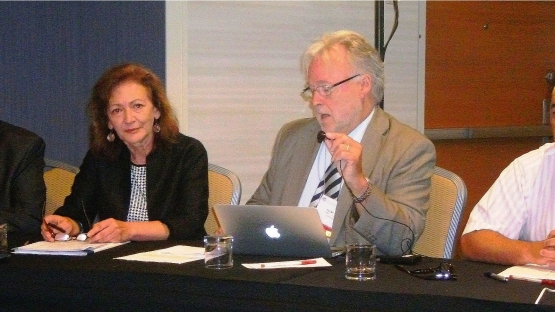Since 2012, the IAEA has been successfully implementing an interregional technical cooperation (TC) project (INT9176) which aims to assist Member States in establishing the frameworks necessary for the safe and secure use and disposal of radioactive sources, from "cradle to grave." The project is jointly-funded by the European Union under its Instrument of Nuclear Safety Cooperation, by the Government of the United States through the Peaceful Uses Initiative, and by the Spanish Consejo de Seguridad Nuclear. The Institute of Nuclear Materials Management invited the IAEA to present the achievements of this project so far at a special session organized during its annual meeting, held from 20 to 24 July in Atlanta, Georgia, USA.
Seven papers were presented by the project counterparts of Albania, Bosnia and Herzegovina, Egypt, Morocco, and South Africa, in addition to international experts and IAEA staff. Using practical examples, the authors of the papers demonstrated their involvement and their interest in the project, providing practical examples of how their institutions have benefitted from participation. The presentations covered the ongoing work of the project, and highlighted examples of the results achieved through it, such as developing and implementing policy and strategy, enhancing regulatory frameworks, preparing the safety case for storage and disposal sites, building capacities for detecting orphan sources, as well as conditioning and disposal of disused sources. Advances in IAEA-supported disposal methodologies for disused sources were also presented, including the use of a mobile hot cell to condition radioactive sources, their storage in appropriate metallic canisters, and the final dispose of the sources in underground, fit-to-purpose bore holes.
The oral presentations were followed by a discussion panel with two keynote speakers, Mrs Rosario Velasco, Vice Chairperson of the Spanish Nuclear Regulatory Council, and Mr Willem Janssens, from the Joint Research Centre of the European Union. The project manager and technical officers of the project also participated in the panel. Mrs Velasco emphasized the importance of a robust and comprehensive regulatory framework in all the countries of the region in order to fully embrace the benefits of nuclear technology for development. Mrs Velasco further highlighted that although a project may require many years of national effort before it achieves the desired results, international cooperation can accelerate the process. She described to the audience the Spanish experience of establishing cradle-to-grave control of radioactive sources. In particular, Mrs Velasco presented the successful experience of Spain gained over 15 years of implementing a voluntary protocol to handle orphan sources found in scrap metal.
Mr Jenssen explored the EU community's legislation for the control of sources, as well as the scope of recently-approved external cooperation instruments to support non-EU countries in enhancing the safety and security of radioactive sources. Both keynote speakers underlined the constructive cooperation with the IAEA in the frame of this interregional project.
The two keynote speeches were followed by a lively and participatory debate between the panel and the audience. Issues related to the technical cooperation project were discussed, including the extent to which category 3 to 5 sources are subject to regulatory oversight, the time that a disused source can be held before being declared as waste, and the benefits of the bore hole disposal option.




